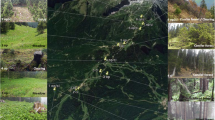Abstract
Terminal restriction fragment length polymorphism (TRFLP) approaches enable the detection and identification of microbial taxa into samples coming from root or soil material DNA extraction. The low taxonomic diversity of arbuscular mycorrhizal (AM) fungi makes this technique a cheap and adequate method for fingerprinting their communities. Here, I describe the TRFLP database approach, a version of the technique in which the AM fungal taxa present in the sample pool is identified for, later, match their presence in the different samples contained in the experiment. A final AM fungal operational taxonomic unit x sample presence–absence matrix is obtained, which allows the subsequent multivariate statistical analysis of the experimental results.
Access this chapter
Tax calculation will be finalised at checkout
Purchases are for personal use only
Similar content being viewed by others
References
van der Heijden MGA, Martin FM, Selosse MA, Sanders IR (2015) Mycorrhizal ecology and evolution: the past, the present, and the future. New Phytol 205:1406–1423
Courtney KC, Bainard LD, Sikes BA et al (2012) Determining a minimum detection threshold in terminal restriction fragment length polymorphism analysis. J Microbiol Methods 88:14–18
Martínez-García LB, Richardson SJ, Tylianakis JM et al (2015) Host identity is a dominant driver of mycorrhizal fungal community composition during ecosystem development. New Phytol 205:1565–1576
Varela-Cervero S, López-García Á, Barea JM, Azcón-Aguilar C (2016) Spring to autumn changes in the arbuscular mycorrhizal fungal community composition in the different propagule types associated to a Mediterranean shrubland. Plant Soil 26:107–120
López-García Á, Varela-Cervero S, Vasar M et al (2017) Plant traits determine the phylogenetic structure of arbuscular mycorrhizal fungal communities. Mol Ecol 26:6948–6959
Dickie IA, FitzJohn RG (2007) Using terminal restriction fragment length polymorphism (T-RFLP) to identify mycorrhizal fungi: a methods review. Mycorrhiza 17:259–270
Koch AM, Kuhn G, Fontanillas P et al (2004) High genetic variability and low local diversity in a population of arbuscular mycorrhizal fungi. Proc Natl Acad Sci U S A 101:2369–2374
López-García Á, Palenzuela J, Barea JM, Azcón-Aguilar C (2014) Life-history strategies of arbuscular mycorrhizal fungi determine succession into roots of Rosmarinus officinalis L., a characteristic woody perennial plant species from Mediterranean ecosystems. Plant Soil 379:247–260
Lee J, Lee S, Young JPW (2008) Improved PCR primers for the detection and identification of arbuscular mycorrhizal fungi. FEMS Microbiol Ecol 65:339–349
Schloss PD, Westcott SL, Ryabin T et al (2009) Introducing mothur: open-source, platform-independent, community-supported software for describing and comparing microbial communities. Appl Environ Microbiol 75:7537–7541
Kumar S, Stecher G, Li M et al (2018) MEGA X: molecular evolutionary genetics analysis across computing platforms. Mol Biol Evol 35:1547–1549
Huson DH, Bryant D (2006) Application of phylogenetic networks in evolutionary studies. Mol Biol Evol 23:254–267
Collins RE, Rocap G (2007) REPK: an analytical web server to select restriction endonucleases for terminal restriction fragment length polymorphism analysis. Nucleic Acids Res 35:W58–W62
Fitzjohn RG, Dickie IA (2007) TRAMPR: AN R package for analysis and matching of terminal-restriction fragment length polymorphism (TRFLP) profiles. Mol Ecol Notes 7:583–587
Oksanen J, Blanchet FG, Kindt R et al (2011) Vegan: community ecology package. R package version 2.0-1. R Project. http://CRAN.R-project.org/package=vegan
Lekberg Y, Gibbons SM, Rosendahl S (2014) Will different OTU delineation methods change interpretation of arbuscular mycorrhizal fungal community patterns? New Phytol 202:1101–1104
Huson DH, Rupp R, Scornavacca C (2011) Phylogenetic networks: concepts, algorithms and applications. Cambridge University Press, Cambridge
Öpik M, Vanatoa A, Vanatoa E et al (2010) The online database MaarjAM reveals global and ecosystemic distribution patterns in arbuscular mycorrhizal fungi (Glomeromycota). New Phytol 188:223–241
Kohout P, Sudova R, Janoušková M et al (2014) Comparison of commonly used primer sets for evaluating arbuscular mycorrhizal fungal communities: is there a universal solution? Soil Biol Biochem 68:482–493
Gollotte A, Van Tuinen D, Atkinson D (2004) Diversity of arbuscular mycorrhizal fungi colonizing roots of the grass species Agrostis capillaris and Lolium perenne in a field experiment. Mycorrhiza 14:111–117
Ohsowski BM, Zaitsoff PD, Öpik M, Hart MM (2014) Where the wild things are: looking for uncultured Glomeromycota. New Phytol 204:171–179
Acknowledgments
The author was supported by Spanish government under the Plan Nacional de I+D+I (project CGL2015-69118-C2-2-P-COEXMED-II) and University of Jaén (Spain) under the Plan 6-UJA postdoctoral fellowship.
Author information
Authors and Affiliations
Corresponding author
Editor information
Editors and Affiliations
Rights and permissions
Copyright information
© 2020 Springer Science+Business Media, LLC, part of Springer Nature
About this protocol
Cite this protocol
López-García, Á. (2020). Analysis of Arbuscular Mycorrhizal Fungal Communities by Terminal Restriction Fragment Length Polymorphism (TRFLP). In: Ferrol, N., Lanfranco, L. (eds) Arbuscular Mycorrhizal Fungi. Methods in Molecular Biology, vol 2146. Humana, New York, NY. https://doi.org/10.1007/978-1-0716-0603-2_10
Download citation
DOI: https://doi.org/10.1007/978-1-0716-0603-2_10
Published:
Publisher Name: Humana, New York, NY
Print ISBN: 978-1-0716-0602-5
Online ISBN: 978-1-0716-0603-2
eBook Packages: Springer Protocols




